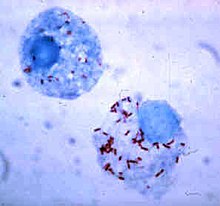Rickettsiales
| Rickettsiales | |
|---|---|

| |
| Rickettsia rickettsii(red dots) in the cell of a deer tick | |
| Scientific classification | |
| Domain: | Bacteria |
| Phylum: | Pseudomonadota |
| Class: | Alphaproteobacteria |
| Order: | Rickettsiales Gieszczykiewicz 1939 (Approved Lists 1980) |
| Families | |
| |
TheRickettsiales,informally calledrickettsias,are an order of smallAlphaproteobacteria.They areobligate intracellular parasites,and some are notable pathogens, includingRickettsia,which causes a variety of diseases in humans, andEhrlichia,which causes diseases in livestock. Another genus of well-known Rickettsiales is theWolbachia,which infect about two-thirds of all arthropods and nearly all filarial nematodes.[2]Geneticstudies support theendosymbiotic theoryaccording to whichmitochondriaand relatedorganellesdeveloped from members of this group.[3]
The Rickettsiales are difficult to culture, as they rely on living eukaryotic host cells for their survival.
Rickettsiales phylogeny[edit]
The Rickettsiales further consist of three known families, theRickettsiaceae,theMidichloriaceae,and theEhrlichiaceae.Most studies also support the inclusion of theHolosporaceae,but one study has challenged this view.[4]In that alternative, the Holosporaceae are the sole representatives of their own order, the Holosporales, and as such not part of the Rickettsiales (see the schematic tree below). Other lineages, not clearly part of any family, have been described, as well. Examples includeCandidatusArcanobacter lacustris[5]and Rickettsiales bacterium Ac37b.
| Schematic ribosomal RNA phylogeny ofAlphaproteobacteria | ||||||||||||||||||||||||
| ||||||||||||||||||||||||
| The cladogram of Rickettsidae has been inferred by Ferlaet al.[6]from the comparison of16S+23Sribosomal RNA sequences. |
Phylogenetic relationship between Rickettsiales and Pelagibacterales (SAR11)[edit]
The phylogenetic relationship between these two groups has yet to reach consensus in the scientific literature.
Early reports suggested that they represented sister clades to each other.[7][8]However, later studies suggested that this relationship is false and was due to a phylogenetic artefact, which artificially groups independent AT-rich and fast-evolving lineages (Rickettsiales and Pelagibacterales have both properties) together.[9][10]Upon correcting for this artefact, the Pelagibacterales form a sister clade to theHyphomicrobiales,RhodobacteralesandCaulobacteralesinstead.
Another study[4]adheres to the sister relationship between the two clades (see schematic tree). In their classification, the relation between the two orders is retained in the subclass, the Rickettsidae, which include the Rickettsiales, the Pelagibacteriales, and the extinctprotomitochondrion(mitochondria themselves are not bacteria, but organelles).[4]
Reductive evolution[edit]
Rickettsiales genomes are undergoing reductive evolution and are typically small (generally < 1,5 Mbp), AT-rich (generally < 40% GC) with a low coding density (generally < 85%) and a relatively high number of pseudogenes.[11]Reduction in genome size, % GC and coding density and genes are generally attributed togenetic driftandMuller's ratchet.Genetic drift is enhanced in Rickettsiales genomes due to low population sizes (given their endosymbiotic nature) and frequent population bottlenecks. Similarly, Muller's ratchet is activated through the lack of recombination andhorizontal gene transfer(the eukaryotic host cell is a natural barrier).
References[edit]
- ^Li D, Fang J, Wen B, Wua X (2021). "Molecular identification of a novel intracellular proteobacteria from scallopChlamys farreri".Aquaculture.539:736565.Bibcode:2021Aquac.53936565L.doi:10.1016/j.aquaculture.2021.736565.S2CID233921822.
- ^Werren JH, Baldo L, Clark ME (2008). "Wolbachia: master manipulators of invertebrate biology".Nat. Rev. Microbiol.6(10): 741–51.doi:10.1038/nrmicro1969.PMID18794912.S2CID12816914.
- ^Thomas S. (2016). Rickettsiales:Biology, Molecular Biology, Epidemiology, and Vaccine Development. pp.529. Springer•ISBN978-3-319-46857-0
- ^abcFerla, M. P.; Thrash, J. C.; Giovannoni, S. J.; Patrick, W. M. (2013)."New rRNA gene-based phylogenies of the Alphaproteobacteria provide perspective on major groups, mitochondrial ancestry and phylogenetic instability".PLOS ONE.8(12): e83383.Bibcode:2013PLoSO...883383F.doi:10.1371/journal.pone.0083383.PMC3859672.PMID24349502.
- ^Martijn J, Schulz F, Zaremba-Niedzwiedzka K, et al. (2015)."Single-cell genomics of a rare environmental alphaproteobacterium provides unique insights into Rickettsiaceae evolution".ISME J.9(11): 2373–85.Bibcode:2015ISMEJ...9.2373M.doi:10.1038/ismej.2015.46.PMC4497978.PMID25848874.
- ^Ferla MP, Thrash JC, Giovannoni SJ, Patrick WM (2013)."New rRNA gene-based phylogenies of the Alphaproteobacteria provide perspective on major groups, mitochondrial ancestry and phylogenetic instability".PLOS ONE.8(12): e83383.Bibcode:2013PLoSO...883383F.doi:10.1371/journal.pone.0083383.PMC3859672.PMID24349502.
- ^Williams KP, Sobral BW, Dickerman AW (2007)."A robust species tree for the alphaproteobacteria".J. Bacteriol.189(13): 4578–86.doi:10.1128/JB.00269-07.PMC1913456.PMID17483224.
- ^Thrash JC, Boyd A, Huggett MJ, et al. (2011)."Phylogenomic evidence for a common ancestor of mitochondria and the SAR11 clade".Sci Rep.1:13.Bibcode:2011NatSR...1E..13T.doi:10.1038/srep00013.PMC3216501.PMID22355532.
- ^Viklund J, Ettema TJ,Andersson SG(2012). "Independent genome reduction and phylogenetic reclassification of the oceanic SAR11 clade".Mol. Biol. Evol.29(2): 599–615.doi:10.1093/molbev/msr203.PMID21900598.
- ^Rodríguez-Ezpeleta N, Embley TM (2012)."The SAR11 group of alpha-proteobacteria is not related to the origin of mitochondria".PLOS ONE.7(1): e30520.Bibcode:2012PLoSO...730520R.doi:10.1371/journal.pone.0030520.PMC3264578.PMID22291975.
- ^Darby AC, Cho NH, Fuxelius HH, Westberg J, Andersson SG (2007). "Intracellular pathogens go extreme: genome evolution in the Rickettsiales".Trends Genet.23(10): 511–20.doi:10.1016/j.tig.2007.08.002.PMID17822801.
